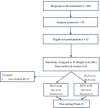Intermittent fasting two days versus one day per week, matched for total energy intake and expenditure, increases weight loss in overweight/obese men and women
- PMID: 35658959
- PMCID: PMC9166203
- DOI: 10.1186/s12937-022-00790-0
Intermittent fasting two days versus one day per week, matched for total energy intake and expenditure, increases weight loss in overweight/obese men and women
Abstract
Background: Intermittent fasting (IF), consisting of either a one-day (IF1) or two consecutive days (IF2) per week, is commonly used for optimal body weight loss. Our laboratory has previously shown an IF1 diet combined with 6d/week of protein pacing (P; 4-5 meals/day evenly spaced, ~ 30% protein/day) significantly enhances weight loss, body composition, and cardiometabolic health in obese men and women. Whether an IF1-P or IF2-P, matched for weekly energy intake (EI) and expenditure (EE), is superior for weight loss, body composition, and cardiometabolic health is unknown.
Methods: This randomized control study directly compared an IF1-P (n = 10) versus an IF2-P (n = 10) diet on weight loss and body composition, cardiovascular (blood pressure and lipids), hormone, and hunger responses in 20 overweight men and women during a 4-week weight loss period. Participants received weekly dietary counseling and monitoring of compliance from a registered dietitian. All outcome variables were assessed pre (week 0) and post (week 5).
Results: Both groups significantly reduced body weight, waist circumference, percent body fat, fat mass, hunger, blood pressure, lipids, glucose, and increased percent fat-free mass (p < 0.05). However, IF2-P resulted in significantly greater reductions in body weight (-29%) and waist circumference (-38%) compared to IF1-P (p < 0.05), and showed a strong tendency for greater reductions in fat mass, glucose, and hunger levels (p < 0.10) despite similar weekly total EI (IF1-P, 9058 ± 692 vs. IF2-P, 8389 ± 438 kcals/week; p = 0.90), EE (~ 300 kcals/day; p = 0.79), and hormone responses (p > 0.10).
Conclusions: These findings support short-term IF1-P and IF2-P to optimize weight loss and improve body composition, cardiometabolic health, and hunger management, with IF2-P providing enhanced benefits in overweight women and men.
Trial registration: This trial was registered March 03, 2020 at www.
Clinicaltrials: gov as NCT04327141 .
Keywords: Fat mass; Fat-free mass; Hunger; Insulin-like growth factor -1 (IGF-1); Intermittent fasting; Protein pacing; Weight loss.
© 2022. The Author(s).
Conflict of interest statement
P.J.A. is a member of the scientific advisory board at Isagenix International LLC, the study’s sponsor. E.G. and A.E.M. are employed by Isagenix International LLC. No authors have financial interests regarding the outcomes of this investigation. All other authors declare no conflict of interest. The funder had no roles in the study design, data collection and analysis, and decision to publish.
Figures
References
-
- Yang F, Liu C, Liu X, Pan X, Li X, Tian L, Sun J, Yang S, Zhao R, An N, Yang X, Gao Y, Xing Y. Effect of epidemic intermittent fasting on cardiometabolic risk factors: a systematic review and meta-analysis of randomized controlled trials. Front Nutr. 2021;8:669325. doi: 10.3389/fnut.2021.669325. - DOI - PMC - PubMed
Publication types
MeSH terms
Substances
Associated data
LinkOut - more resources
Full Text Sources
Medical
Miscellaneous




